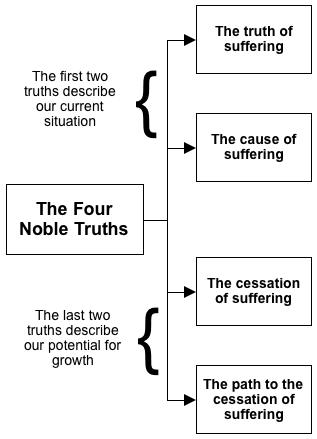Notes
Introduction to the Four Noble Truths
The Buddha's first teaching described his realization in terms of four facts about existence, known as the Four Noble Truths.
We need to pay attention to both our present situation (described by the first two NTs) and our vast human potential (described by the last two NTs).
- First NT: the truth of suffering
- We "suffer," i.e., we feel dissatisfaction, even when things seem to be going well.
- We have difficulties and encounter unsatisfactory circumstances because we cannot control our bodies, emotions, or life experiences; thus, we can never find lasting happiness & security.
- Second NT: the cause of suffering
- The happiness & suffering that seem to come from external objects really come largely from our own attitudes towards our experience.
- The disturbing attitudes include clinging attachment, anger, arrogance, jealousy & confusion.
- Choices made & actions done under the influence of these attitudes have effects and influence our present & future experiences.
- These disturbing attitudes are rooted in the ignorance that misinterprets how we, others & all phenomena exist.
- Seeing phenomena as solid, concrete, and existing in its own right & under its own power prevents us from seeing that all things are fluid & dependent, and we forget that change is possible.
- Third NT: the cessation of suffering
- The disturbing attitudes are like clouds, obscuring the pure, clear nature of our open-sky mind.
- We do have the potential to end unsatisfactory experiences and the disturbing attitudes & negative actions which cause them.
- Fourth NT: the path to the cessation of suffering
- We must develop attitudes to counteract ignorance & self-centeredness, the two chief causes of our ills.
- Ignorance is remedied by realizing emptiness, the lack of independent existence of all phenomena.
- Emptiness does not mean total non-existence.
- It means that things arise dependently, and thus are flexible & changeable.
- The three higher trainings lead us to liberation from cyclic existence:
- ethical conduct
- meditative stabilization
- wisdom
- Self-centeredness (self-preoccupation) is remedied by cultivating compassion & love.
- When we believe our own happiness & suffering are more important than others', it can obscure love & compassion.
- To dissolve self-centeredness, we cultivate compassion (the wish that all beings be free from suffering & its causes) & love (the wish that all beings have happiness & its causes).
- EX: Forgiving our enemies means letting go of our hatred & anger towards them.
- Realize that their harmful behavior stems from their own pain & chaos, which lead them to use harmful methods to try to get happiness.
- By seeing this, we can have more understanding & compassion, and with clearer minds, actively choose appropriate methods to stop the harm.
- We must develop attitudes to counteract ignorance & self-centeredness, the two chief causes of our ills.
The Context in Which the Four Noble Truths Were Taught
This teaching is set against the backdrop of the Buddhist notion of the mind.
- By "the mind," we mean any conscious experience, including sense perceptions, thoughts, emotions, feelings (whether pleasant, unpleasant, or neutral), views, attitudes, and moods. The mind is a formless, conscious, existing phenomenon.
- When death separates mind from body, mind goes on to take another rebirth.
- Habits & imprints from previous lives' actions influence our present life; our present actions influence the future.
- Thus, events & experiences arise due to causes & conditions.
- So we need to pay attention to our choices, our actions, and the causes we create.
Sentient Beings and Their Worlds
The Buddha described six realms of sentient beings: humans, animals, gods, demigods, hungry ghosts & hell beings.
- These realms arise due to the functioning of cause & effect.
- Our actions (karma) create the causes for us to be attracted to the various types of rebirth.
- When we act under the influence of disturbing attitudes, we stay trapped in cyclic existence.
- When we act wisely & compassionately, we create the causes for happiness, including fortunate rebirths and ultimately liberation & enlightenment.
- To become an arhat (i.e., attain liberation), one must eliminate the deluded obscurations that cause cyclic existence.
- To become a Buddha (attain full enlightenment), one must remove the obscurations to omniscience (subtle imprints on the mindstream).
- The altruistic intention (bodhichitta, concern for the welfare of all sentient beings) motivates us to attain full enlightenment.
- Those who have entered the path to Buddhahood are called Bodhisattvas.
- Each of us already has the Buddha nature as the nature of our mind, so there is always reason for hope.
- Personal responsibility is essential; we must engage in & accomplish the spiritual path ourselves.
- However, we can rely on (take refuge in) the Three Jewels: the Buddha, the Dharma, & the Sangha.
How to Approach the Path
Develop discriminating wisdom (i.e., question, research, reason, & apply the Dharma teachings to daily life to see if they work) rather than accept the path on blind faith.
- Allow time & space to digest, contemplate, test out, and integrate the teachings into our lives.
- Allow time & patience to understand emptiness, the ultimate, deeper nature of existence.
- Persevere with joy, knowing that knowledge, wisdom & internal transformation occur gradually.
There are three levels of spiritual practitioner, and we must go through all three phases on the path to enlightenment.
- Initial level: We observe karma & its effects, begin to discriminate between constructive & destructive choices & actions, and develop a solid ethical foundation.
- Middle level: We gain a deeper understanding of the 4NTs and develop a stronger determination to be free from cyclic existence and attain liberation.
- Advanced level: We generate bodhicitta, apply the teachings to unfavorable circumstances we encounter (thus transforming them into the path), develop the wisdom realizing emptiness, and apply this altruistic intention & wisdom to the Bodhisattvas' trainings.

